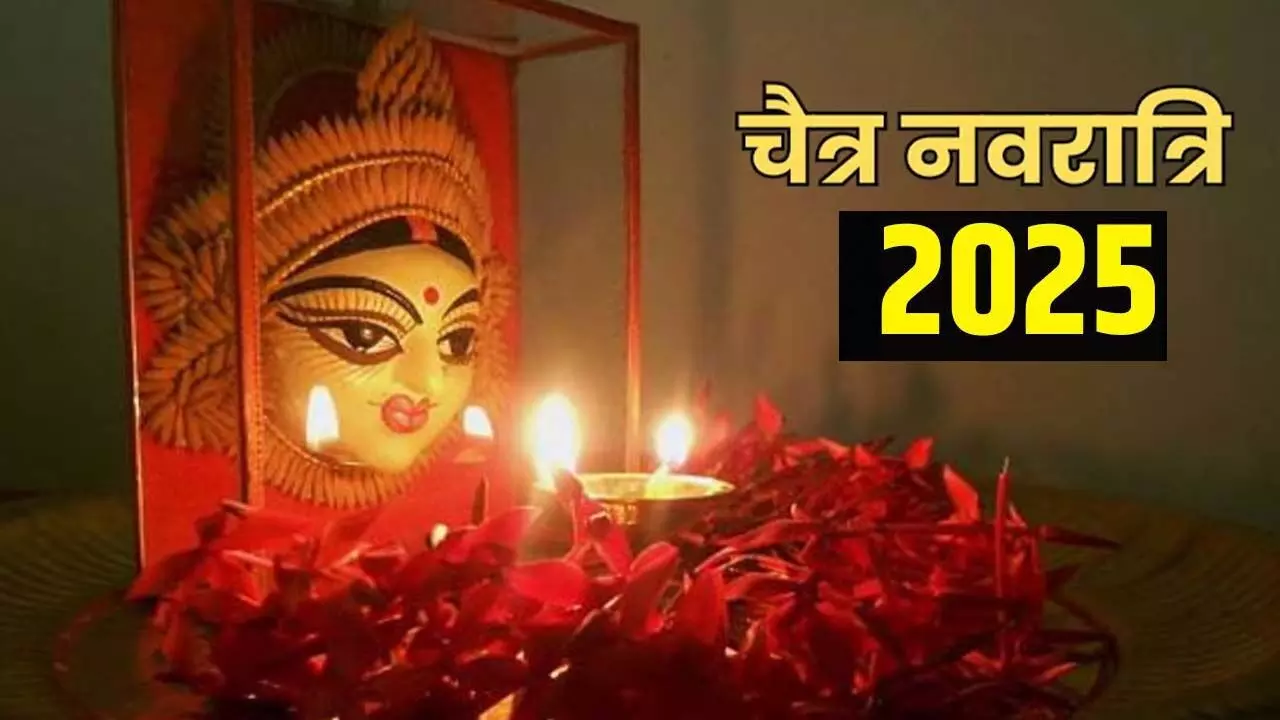TRENDING TAGS :
Chaitra Navratri 2025: Date, Time, History, Significance, Rituals, and Celebrations Across India
Chaitra Navratri (PC- Social Media)
Chaitra Navratri 2025 is set to begin on Sunday, March 30, and will conclude on Monday, April 7. This nine-day Hindu festival is dedicated to honoring Goddess Durga and her nine divine forms, collectively known as Navadurga. It marks the beginning of the Hindu lunar new year and is observed with great devotion across India. The festival is considered an auspicious period for spiritual practices, fasting, and seeking blessings for prosperity, health, and well-being. Devotees observe rituals and prayers throughout these nine days to honor Goddess Durga and seek her divine blessings.
The festival begins with Ghatasthapana, also known as Kalash Sthapana, a ritual that marks the invocation of Goddess Durga. In 2025, the auspicious time for Ghatasthapana is from 6:13 AM to 10:22 AM on March 30. An alternative Abhijit Muhurat is from 12:01 PM to 12:50 PM on the same day. Pratipada Tithi, the first lunar day of the waxing phase, begins at 4:27 PM on March 29 and ends at 12:49 PM on March 30. Ghatasthapana is a significant ritual where devotees establish a sacred pot filled with water, mango leaves, and a coconut placed on top. This pot is worshipped throughout the nine days as a representation of Goddess Durga's divine presence in the household.
Each day of Chaitra Navratri is dedicated to a different form of Goddess Durga. On March 30, the first day, devotees worship Maa Shailaputri, who represents purity and strength. The second day, March 31, is dedicated to Maa Brahmacharini, known for her penance and devotion. On April 1, the third day, devotees honor Maa Chandraghanta, the goddess who symbolizes bravery and serenity. The fourth day, April 2, is dedicated to Maa Kushmanda, believed to be the creator of the universe. On April 3, the fifth day, people worship Maa Skandamata, the mother of Lord Kartikeya. The sixth day, April 4, is dedicated to Maa Katyayani, a fierce form of Goddess Durga. On April 5, the seventh day, Maa Kalaratri, the destroyer of darkness, is worshipped. The eighth day, April 6, is dedicated to Maa Mahagauri, who signifies purity and tranquility. Finally, on April 7, the ninth day, devotees worship Maa Siddhidatri, who grants spiritual enlightenment and divine blessings.
Chaitra Navratri holds immense spiritual and cultural significance. It is believed that during these nine days, Goddess Durga descends to bless her devotees, helping them overcome obstacles and attain spiritual growth. The festival symbolizes the triumph of good over evil, commemorating the victory of Goddess Durga over the demon Mahishasura. Additionally, it aligns with the onset of spring and the Hindu New Year, marking a period of renewal and setting intentions for the year ahead. Devotees seek strength, wisdom, and prosperity during this time, believing that sincere prayers and fasting will help purify the mind and soul.
Devotees observe various rituals during Chaitra Navratri, including fasting, prayer, and meditation. Many maintain a nine-day fast, consuming only specific foods like fruits, milk, and items made from buckwheat flour (kuttu atta) and water chestnut flour (singhare ka atta). Some undertake a Nirjala vrat, abstaining from both food and water, breaking their fast either after evening prayers or on the tenth day. Daily worship involves offering prayers to the respective form of Goddess Durga for that day, reciting religious scriptures, and performing aarti. Chanting of Durga Saptashati, Devi Mahatmya, and other sacred texts is also common during this time.
A significant ritual during Navratri is the Kanya Puja, performed on the eighth (Ashtami) or ninth (Navami) day. In this ritual, young girls, symbolizing the nine forms of Goddess Durga, are invited into homes, worshipped, and offered prasad, which typically includes puri, chana, and halwa. They are also given gifts and money as a token of respect and blessings. This tradition highlights the importance of the divine feminine and seeks the blessings of young girls, who are considered the earthly embodiment of Goddess Durga. Many devotees believe that honoring Kanya Puja brings prosperity and happiness to their households.
Chaitra Navratri is celebrated with regional variations across India. In North India, homes and temples are adorned with flowers, and bhajan-kirtans (devotional songs) are performed to create a spiritual atmosphere. In Maharashtra, the festival coincides with Gudi Padwa, marking the New Year. People hoist a ‘Gudi’ outside their homes as a symbol of good health and prosperity. In the Southern states, the festival is celebrated as Ugadi, which marks the beginning of the Telugu and Kannada New Year. In West Bengal and Odisha, the focus remains on the worship of Goddess Durga, with temples conducting special pujas and cultural programs. Despite regional differences, the essence of the festival remains the same—devotion, prayer, and spiritual awakening.
The culmination of Chaitra Navratri is marked by Ram Navami, celebrated on the ninth day, which commemorates the birth of Lord Rama. Devotees read the Ramayana, sing bhajans, and visit temples dedicated to Lord Rama, seeking his blessings for righteousness and virtue. Ram Navami is an important day for Hindus, as Lord Rama is considered the embodiment of dharma (righteousness). Special prayers, bhajans, and recitations of the Ramcharitmanas are conducted in temples and households. Many devotees observe fasts on this day and break them only after the evening aarti.
In some regions, Chaitra Navratri is also associated with the agricultural cycle, marking the beginning of the harvest season. Farmers seek the blessings of Goddess Durga for a prosperous harvest and a fruitful year ahead. The festival also promotes discipline, as devotees follow strict fasting rules and dedicate themselves to spiritual practices. It serves as a time for introspection, self-discipline, and personal growth. Many people use this period to cleanse their bodies and minds, setting positive intentions for the year ahead.
During Chaitra Navratri, special arrangements are made in temples across India. Grand celebrations take place at famous temples like Vaishno Devi in Jammu and Kashmir, Kamakhya Temple in Assam, and Jhandewalan Temple in Delhi. Devotees from different parts of the country visit these temples to seek the blessings of Goddess Durga. The temples remain crowded throughout the festival, with devotees offering flowers, sweets, and other offerings to the deity. The atmosphere is filled with devotion, as people sing hymns and participate in religious discourses.
Another highlight of Chaitra Navratri is the nine-day color tradition, where devotees wear a specific color each day to honor the goddess being worshipped. These colors symbolize different attributes of Goddess Durga and bring positive energy. The colors for 2025 are expected to follow the traditional sequence, including red, blue, yellow, green, and others, each representing qualities like power, wisdom, and prosperity. Many devotees also decorate their homes with these colors, creating a spiritual and festive ambiance.
In modern times, while many people follow traditional rituals, some also celebrate Navratri in a contemporary way. With the advent of technology, virtual darshans, online pujas, and live streaming of temple events have become popular. People who are unable to visit temples physically can participate in prayers and rituals from the comfort of their homes. Social media platforms are flooded with devotional messages, Navratri wishes, and spiritual content, allowing devotees to stay connected with their faith.
Chaitra Navratri also has a deep environmental connection. Since it coincides with the beginning of spring, it is a time when nature starts rejuvenating after winter. Many devotees take this opportunity to plant trees, clean their surroundings, and contribute to environmental conservation efforts. Some people also avoid using plastic and non-biodegradable materials during the festival to promote sustainability. This aligns with the belief that Goddess Durga represents nature’s power and should be honored by protecting the environment.
In summary, Chaitra Navratri 2025, from March 30 to April 7, is a period of profound spiritual significance, marked by devotion, fasting, and cultural celebrations across India. It is a time of prayer, self-discipline, and reconnecting with divine energies. The festival brings people together, fostering a sense of community and devotion. Whether through traditional rituals, temple visits, or modern celebrations, Chaitra Navratri remains a cherished festival that continues to inspire millions.
Related Searches: Chaitra Navratri 2025 dates, Chaitra Navratri significance, Chaitra Navratri rituals, Ghatasthapana 2025 timing, Ram Navami 2025 date, Chaitra Navratri fasting rules, Chaitra Navratri celebrations in India, Navadurga forms, Kanya Puja significance, Chaitra Navratri regional variations.


